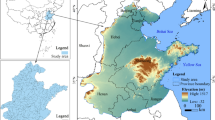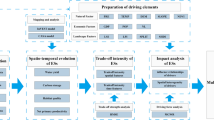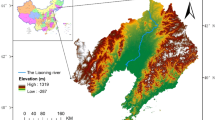Abstract
Understanding the trade-offs among ecosystem services (ESs) at multiple scales is a key challenge to effective environmental management. However, the scale effect of ESs trade-offs in the Qinghai-Tibetan Plateau (QTP) has received little attention. This study investigated the scale effects of ESs trade-offs in Bailongjiang Watershed (BLJW), a typical transitional ecotone from the Loess Plateau to the Tibetan Plateau with multiple ESs, intensive human activities and frequent geological disasters in the Eastern Margin of the QTP, China. Four key ESs including food supply (FS), soil conservation (SC), water conservation (WC), and habitat quality (HQ) in BLJW in 1990, 2002, and 2016 were mapped to analyze the scale effects at the watershed, county, and township scales. The results indicated varying scale-related temporal and spatial relationships among FS, SC, WC, and HQ. The trade-offs between FS-SC and FS-WC initially increased and then decreased during 1990–2002 and 2002–2016, respectively, while the trade-offs between SC-WC, SC-HQ, HQ-WC, and HQ-FS first decreased and then increased at the same period. The magnitudes of the trade-offs among the four ESs are in the order of watershed scale > township scale > county scale. Among the major land-use types in BLJW, the trade-offs between WC-FS and between HQ-FS in farmland and grassland were higher than those of other land uses. There is a strong trade-off between SC-HQ in forestland and a weak trade-off between SC-WC in farmland and grassland. The trade-offs between the six ESs pairs varied and were scale-dependent mainly due to spatial heterogeneity in the landscape and in human activities. Understanding the ESs trade-offs at the watershed, county, and township scales provides a scientific basis for the formulation of environmental management strategies at appropriate spatial scales. At the BLJW watershed scale, more attention should be paid on farmland and grassland planning and its management, also, forestland should be enlarged if possible. At the county and township scales, land consolidation and planning should be paid more attention to develop ecological agricultural tourism and multi-functional landscapes for strategic spatial planning and integrated watershed management.
Similar content being viewed by others
References
Bai Y, Chen Y, Alatalo JM, et al. (2020) Scale effects on the relationships between land characteristics and ecosystem services: A case study in Taihu Lake Basin, China. Sci Total Environ 716: 137083. https://doi.org/10.1016/j.scitotenv.2020.137083
Bennett EM, Peterson GD, Gordon LJ (2009) Understanding relationships among multiple ecosystem services. Ecol Lett 12: 1394–1404. https://doi.org/10.1111/j.1461-0248.2009.01387.x
Bradford JB, D’Amato AW (2012) Recognizing trade-offs in multi-objective land management. Front Ecol Environ 10: 210–216. https://doi.org/10.1890/110031
Carpenter SR, Mooney HA, Agard J, et al. (2009) Science for managing ecosystem services: Beyond the Millennium Ecosystem Assessment. Proc Natl Acad Sci U.S.A. 106:1305–1312. https://doi.org/10.1073/pnas.0808772106
Carreño L, Frank FC, Viglizzo EF (2012) Tradeoffs between economic and ecosystem services in Argentina during 50 years of land-use change. Agric Ecosyst Environ 154: 68–77. https://doi.org/10.1016/j.agee.2011.05.019
Castellazzi MS, Brown I, Poggio L, et al. (2010) Multi-scale modelling of ecosystem services: An iterative approach. In: Modelling for Environment’s Sake: Proceedings of the 5th Biennial Conference of the International Environmental Modelling and Software Society, IEMSs 2010. pp 683–691.
Cui F, Tang H, Zhang Q, et al. (2019) Integrating ecosystem services supply and demand into optimized management at different scales: A case study in Hulunbuir, China. Ecosyst Serv 39:100984. https://doi.org/10.1016/j.ecoser.2019.100984
Cord AF, Bartkowski B, Beckmann M, et al. (2017) Towards systematic analyses of ecosystem service trade-offs and synergies: Main concepts, methods and the road ahead. Ecosyst Serv 28: 264–272. https://doi.org/10.1016/j.ecoser.2017.07.012
Costanza R, Arge R, de Groot R, et al. (1997) The value of the world’s ecosystem services and natural capital. Ecol Econ 387(6630): 253–260. https://doi.org/10.1038/387253a0.
Dai EF, Wang XL, Zhu JJ, et al. (2015) Methods, tools and research framework of ecosystem service trade-offs. Geogr Res 30:1250–1259. (In Chinese) https://doi.org/10.11821/dlyj201606001
Dai LW, Tang HP, Zhang Q, et al. (2020) The trade-off and synergistic relationship among ecosystem services: A case study in Duolun County, the agropastoral ecotone of northern China. Acta Ecol Sin 40(9):2863–2876. (In Chinese) https://doi.org/10.5846/stxb201904050663
Daily GC (1997) Nature’s Services: Societal Dependence on Natural Ecosystems. Island Press, Washington, D.C. https://doi.org/10.2307/3244191.
Dennis M, James P (2017) Ecosystem services of collectively managed urban gardens: Exploring factors affecting synergies and tradeoffs at the site level. Ecosyst Serv 26:17–26. https://doi.org/10.1016/j.ecoser.2017.05.009
Dou HS, Li XB, Li SK, et al. (2020) Mapping ecosystem services bundles for analyzing spatial trade-offs in Inner Mongolia, China. J Cleaner Prod 256: 120444. https://doi.org/10.1016/j.jclepro.2020.120444
Diodato N, Bellocchi G (2010) MedREM, a rainfall erosivity model for the Mediterranean region. J Hydrol 387(1):119–127. https://doi.org/10.1016/j.jhydrol.2010.04.003
Emmett BA, Cooper D, Smart S, et al. (2016) Spatial patterns and environmental constraints on ecosystem services at a catchment scale. Sci Total Environ 572:1586–1600. https://doi.org/10.1016/j.scitotenv.2016.04.004
Fan Y, Jin X, Gan L, et al. (2018) Spatial identification and dynamic analysis of land use functions reveals distinct zones of multiple functions in eastern China. Sci Total Environ 642:33–44. https://doi.org/10.1016/j.scitotenv.2018.05.383
Feng Q, Zhao WW, Fu BJ, et al. (2017) Ecosystem service tradeoffs and their influencing factors: A case study in the Loess Plateau of China. Sci Total Environ 607–608:1250–1263. https://doi.org/10.1016/j.scitotenv.2017.07.079
Fernandez-Campo M, Rodríguez-Morales B, Dramstad WE, et al. (2017) Ecosystem services mapping for detection of bundles, synergies and trade-offs: Examples from two Norwegian municipalities. Ecosyst Serv 28: 283–297. https://doi.org/10.1016/j.ecoser.2017.08.005.
Fu BJ, Yu DD (2016) Trade-off analyses and synthetic integrated method of multiple ecosystem services. Resour Sci 38:1379–1390. (In Chinese) https://doi.org/10.18402/resci.2016.01.01
Gong J, Cao EJ, Xie YC, et al. (2021) Integrating ecosystem services and landscape ecological risk into adaptive management: Insights from a western mountain-basin area, China. J Environ Manage 281:111817. https://doi.org/10.1016/j.jenvman.2020.111817
Gong J, Liu DQ, Zhang JX, et al. (2019a) Tradeoffs/synergies of multiple ecosystem services based on land use simulation in a mountain-basin area, western China. Ecol Indic 99: 283–293. https://doi.org/10.1016/j.ecolind.2018.12.027
Gong J, Xie YC, Cao EJ, et al. (2019b) Integration of InVEST-habitat quality model with landscape pattern indexes to assess mountain plant biodiversity change: A case study of Bailongjiang watershed in Gansu Province. J Geog Sci 29:1193–1210. https://doi.org/10.1007/s11442-019-1653-7
Gong J, Xie YC (2018) Spatiotemporal Changes of Watershed Landscape Pattern and Ecosystem Services: A Case Study of Bailongjiang Watershed in Gansu. Science Press.
Grasso M (1998) Ecological-economic model for optimal mangrove trade off between forestry and fishery production: Comparing a dynamic optimization and a simulation model. Ecol Modell 112:131–150. https://doi.org/10.1016/S0304-3800(98)00076-3
Grêt-Regamey A, Celio E, Klein TM, et al. (2013) Understanding ecosystem services trade-offs with interactive procedural modeling for sustainable urban planning. Landscape Urban Plann 109: 107–116. https://doi.org/10.1016/j.landurbplan.2012.10.011
Guan F J, Liu L H, Liu J W, et al. (2021) Systematically promoting the construction of natural ecological protection and governance capacity: Experts comments on Master Plan for Major Projects of National Important Ecosystem Protection and Restoration (2021–2035). J Nat Resour 36(2):290–299. https://doi.org/10.31497/zrzyxb.20210202
Han HQ, Liu Y, Gao HJ, et al. (2020) Tradeoffs and synergies between ecosystem services: A comparison of the karst and non-karst area. J Mt Sci 17(5):1221–1234. https://doi.org/10.1007/s11629-019-5667-5
Hein L, van Koppen K, de Groot RS, (2005) Spatial scales, stakeholders and the valuation of ecosystem services. Ecol Econ 57:209–228. https://doi.org/10.1016/j.ecolecon.2005.04.005
Hou Y, Lü Y H, Chen W, et al. (2017) Temporal variation and spatial scale dependency of ecosystem service interactions: A case study on the central Loess Plateau of China. Landsc Ecol 32:1201–1217. https://doi.org/10.1007/s10980-017-0497-8
Howe C, Suich H, Vira B, et al. (2014) Creating win-wins from trade-offs? Ecosystem services for human well-being: A meta-analysis of ecosystem service trade-offs and synergies in the real world. Global Environ Change 28:263–275. https://doi.org/10.1016/j.gloenvcha.2014.07.005
Jia X, Fu BJ, Feng X, et al. (2014) The tradeoff and synergy between ecosystem services in the Grain-for-Green areas in Northern Shaanxi, China. Ecol Indic 43:103–113. https://doi.org/10.1016/j.ecolind.2014.02.028
Jopke C, Kreyling J, Maes J, et al. (2015) Interactions among ecosystem services across Europe: Bagplots and cumulative correlation coefficients reveal synergies, trade-offs, and regional patterns. Ecol Indic 49:46–52. https://doi.org/10.1016/j.ecolind.2014.09.037
Kareiva P, Tallis H, Ricketts TH, et al. (2011) Natural Capital: Theory and Practice of Mapping Ecosystem Services. Oxford University Press.
Konarska KM, Sutton PC, Castellon M (2002) Evaluating scale dependence of ecosystem service valuation: a comparison of NOAA-AVHRR and Landsat TM datasets. Ecol Econ 41:491–507. https://doi.org/10.1016/S0921-8009(02)00096-4
Lee H, Lautenbach S (2016) A quantitative review of relationships between ecosystem services. Ecol Indic 66:340–351. https://doi.org/10.1016/j.ecolind.2016.02.004
Li RN, Zheng H, O’Connor P, et al. (2021) Time and space catch up with restoration programs that ignore ecosystem service trade-offs. Sci Adv 7: eabf8650. https://doi.org/10.1126/sciadv.abf8650
Li SC, Zhang Y, Wang Z, et al. (2018) Mapping human influence intensity in the Tibetan Plateau for conservation of ecological service functions. Ecosyst Serv 30: 276–286. https://doi.org/10.1016/j.ecoser.2017.10.003
Li T, Lü YH, Fu BJ, Hu WY, et al. (2019) Bundling ecosystem services for detecting their interactions driven by largescale vegetation restoration: Enhanced services while depressed synergies. Ecol Indic 99:332–342. https://doi.org/10.1016/j.ecolind.2018.12.041
Li XS, Zhu YM, Zhao L, et al. (2015). Ecosystem services value change in Qinglong County from dynamically adjusted value coefficients. Chinese J Eco-Agric 25(3):373–281. (In Chinese) https://doi.org/10.13930/j.cnki.cjea.140595
Liu L, Wang Z, Wang Y, et al. (2019) Trade-off analyses of multiple mountain ecosystem services along elevation, vegetation cover and precipitation gradients: A case study in the Taihang Mountains. Ecol Indic 103: 94–104. https://doi.org/10.1016/j.ecolind.2019.03.034
Liu DQ (2019) Spatiotemporal tradeoffs and synergy of watershed ecosystem services: A case study of Bailongjiang Watershed in Gansu. Lanzhou University. (In Chinese).
Liu S, Cheng F, Dong S, et al. (2017) Spatiotemporal dynamics of grassland aboveground biomass on the Qinghai-Tibet Plateau based on validated MODIS NDVI. Sci Rep UK 7:1–10. https://doi.org/10.1038/s41598-017-04038-4
Luo Y, Lü Y, Fu BJ, et al. (2019) Half century change of interactions among ecosystem services driven by ecological restoration: Quantification and policy implications at a watershed scale in the Chinese Loess Plateau. Sci Total Environ 651:2546–2557. https://doi.org/10.1016/j.scitotenv.2018.10.116
Lu N, Fu B, Jin T, et al. (2014). Trade-off analyses of multiple ecosystem services by plantations along a precipitation gradient across Loess Plateau landscapes. Landsc Ecol 29:1697–1708. https://doi.org/10.1007/s10980-014-0101-4
Lü YH, Lü D, Feng XM, et al. (2020) Multi-scale analyses on the ecosystem services in the Chinese Loess Plateau and implications for dryland sustainability. Curr Opin Env Sust 48:1–9. https://doi.org/10.1016/j.cosust.2020.08.001
MA (Millennium Ecosystem Assessment) (2005) Ecosystems and Human Well-Being: A Framework for Assessment. Island Press, Washington, DC.
Mach ME, Martone RG, Chan KMA (2015) Human impacts and ecosystem services: Insufficient research for trade-off evaluation. Ecosyst Serv 16: 112–120. https://doi.org/10.1016/j.ecoser.2015.10.018
Mitchell MGE, Bennett EM, Gonzalez A. (2015) Strong and nonlinear effects of fragmentation on ecosystem service provision at multiple scales. Environ Res Lett 10.094014 https://doi.org/10.1088/1748-9326/10/9/094014
Mouchet MA, Lamarque P, Martín-López B, et al. (2014) An interdisciplinary methodological guide for quantifying associations between ecosystem services. Global Environ Change 28:298–308. https://doi.org/10.1016/j.gloenvcha.2014.07.012
Pan J, Wei S, Li Z (2020) Spatiotemporal pattern of trade-offs and synergistic relationships among multiple ecosystem services in an arid inland river basin in NW China. Ecol Indic 114:106345. https://doi.org/10.1016/j.ecolind.2020.106345
Qiao XN, Gu YY, Zou CX, et al. (2019) Temporal variation and spatial scale dependency of the trade-offs and synergies among multiple ecosystem services in the Taihu Lake Basin of China. Sci Total Environ 651:218–229. https://doi.org/10.1016/j.scitotenv.2018.09.135
Qiu JX, Turner MG (2013) Spatial interactions among ecosystem services in an urbanizing agricultural watershed. Proc Natl Acad Sci U.S.A. 110 (29): 12149–12154. https://doi.org/10.1073/pnas.13105391110
Raudsepp-Hearne C, Peterson GD, Bennett EM (2010) Ecosystem service bundles for analyzing tradeoffs in diverse landscapes. Proc Natl Acad Sci U.S.A. 107: 5242–5247. https://doi.org/10.1073/pnas.0907284107
Rodríguez JP, Beard TD, Bennett EM, et al. (2006) Trade-offs across space, time, and ecosystem services. Ecol Soc 11. https://doi.org/10.5751/ES-01667-110128
Sang WG, Jan CA (2016) China draws lines to green future. Nature 531:305. https://doi.org/10.1038/531305b
Scholes RJ, Reyers B, Biggs R, et al. (2013) Multi-scale and cross-scale assessments of social-ecological systems and their ecosystem services. Curr Opin Env Sust 5:16–25. https://doi.org/10.1016/j.cosust.2013.01.004
Seppelt R, Dormann C F, Eppink F V, et al. (2011) A quantitative review of ecosystem service studies: Approaches, shortcomings and the road ahead. J Appl Ecol 48(3):630–636. https://doi.org/10.1111/j.1365-2664.2010.01952.x
Sharp R, Douglass J, Wolny S, et al. (2020) InVEST 3.8.9.post1+ug.G48b9aa8 User’s Guide. The Natural Capital Project, Stanford University, University of Minnesota, The Nature Conservancy, and World Wildlife Fund.
Shen J, Li S, Liang Z, et al. (2020) Exploring the heterogeneity and nonlinearity of trade-offs and synergies among ecosystem services bundles in the Beijing-Tianjin-Hebei urban agglomeration. Ecosyst Serv 43: 101103. https://doi.org/10.1016/j.ecoser.2020.101103
Sherrouse BC, Clement JM, Semmens DJ (2011) A GIS application for assessing, mapping, and quantifying the social values of ecosystem services. Appl Geogr 31:748–760. https://doi.org/10.1016/j.ecolind.2013.07.008
Su C H, Dong M, Fu BJ, et al. (2020) Scale effects of sediment retention, water yield, and net primary production: A case-study of the Chinese Loess Plateau. Land Degrad Dev 31:1408–1421. https://doi.org/10.1002/ldr.3536
Sun BD, Cui LJ, Li W, et al. (2018) A review of spatial-scale transformation in wetland ecosystem service evaluation. Acta Ecol Sin 38: 2607–2615. (In Chinese) https://doi.org/10.5846/stxb201704260764
Sun Y, Hao RF, Qiao JM, et al. (2020) Function zoning and spatial management of small watersheds based on ecosystem disservice bundles. J Cleaner Prod 255:120285. https://doi.org/10.1016/j.jclepro.2020.120285
Sun ZX, Liu ZF, He CY, et al. (2016) Multi-scale analysis of ecosystem service trade-offs in urbanizing drylands of China: A case study in the Hohhot-Baotou-Ordos-Yulin Region. Acta Ecol Sin 36:488–4891. (In Chinese) https://doi.org/10.5846/stxb201507051423
Tao F, Yokozawa M, Zhang Z, et al. (2005) Remote sensing of crop production in China by production efficiency models: Models comparisons, estimates and uncertainties. Ecol Modell 183:385–396. https://doi.org/10.1016/j.ecolmodel.2004.08.023
Trodahl MI, Jackson BM, Deslippe JR, et al. (2017) Investigating trade-offs between water quality and agricultural productivity using the Land Utilisation and Capability Indicator (LUCI): A New Zealand application. Ecosyst Serv 26 (B):388–399. https://doi.org/10.1016/j.ecoser.2016.10.013
Turkelboom F, Leone M, Jacobs S, et al. (2018) When we cannot have it all: Ecosystem services trade-offs in the context of spatial planning. Ecosyst Serv 29:566–578. https://doi.org/10.1016/j.ecoser.2017.10.011
Turner KG, Odgaard MV, Bøcher PK, et al. (2014) Bundling ecosystem services in Denmark:Trade-offs and synergies in a cultural landscape. Landsc Urban Plann 125:89–104. https://doi.org/10.1016/j.landurbplan.2014.02.007
Van Overwalle G (2005) Protecting and sharing biodiversity and traditional knowledge: Holder and user tools. Ecol Econ 53:585–607. https://doi.org/10.1016/j.ecolecon.2004.10.014
Villa F, Bagstad KJ, Voigt B, et al. (2014) A methodology for adaptable and robust ecosystem services assessment. PLOS ONE 9(3):1–18. https://doi.org/10.1371/journal.pone.0091001
Wang S, Fu BJ (2013) Trade-offs between forest ecosystem services. For Policy Econ 26:145–146. https://doi.org/10.1016/j.forpol.2012.07.014
Wang XF, Ma X, Feng XM, et al. (2019) Spatial-temporal characteristics of trade-off and synergy of ecosystem services in key vulnerable ecologicalareas in China. Acta Ecol Sin 39:7344–7355. (In Chinese)
Wen X, Deng X, Zhang F (2019) Scale effects of vegetation restoration on soil and water conservation in a semi-arid region in China: Resources conservation and sustainable management. Resour Conserv Recyl Adv 151:104474. https://doi.org/10.1016/j.resconrec.2019.104474
West PC, Gibbs HK, Monfreda C, et al. (2010) Trading carbon for food: Global comparison of carbon stocks vs. crop yields on agricultural land. Proc Natl Acad Sci U.S.A. 107:19645–19648. https://doi.org/10.1073/pnas.1011078107
Wu JG (2004). Effects of changing scale on landscape pattern analysis: Scaling relations. Landsc Ecol 19:125–138. https://doi.org/10.1023/B:LAND.0000021711.40074.ae.
Wu JG (2013) Landscape sustainability science: Ecosystem services and human well-being in changing landscapes. Landsc Ecol 28:999–1023. https://doi.org/10.1007/s10980-013-9894-9
Wu HY, Lu ZH (2021) Review and thinking of water management practice in Taihu Basin. J Hydraul Eng 52(3):277–290. (In Chinese) https://doi.org/10.13243/j.cnki.slxb.20200728
Wu JG, Zhao Y, Yu C, et al. (2017) Land management influences trade-offs and the total supply of ecosystem services in alpine grassland in Tibet, China. J Environ Manage 193: 70–78. https://doi.org/10.1016/j.jenvman.2017.02.008
Wu SY, Li SC (2019) Ecosystem service relationships: Formation and recommended approaches from a systematic review. Ecol Indic 99:1–11. https://doi.org/10.1016/j.ecolind.2018.11.068
Xie GD, Lu CX, Leng YF, et al. (2003) Ecological assets valuation of the Tibetan Plateau. J Nat Resour 18:189–196. (In Chinese)
Xie GD., Zhen L, Lu CX, et al. (2010) Applying value transfer method for eco-service valuation in China. J Resour Ecol 1:51–59. (In Chinese) https://doi.org/10.3969/j.issn.1674-764x.2010.01.007
Xu XB, Yang GS, Tan Y, et al. (2018) Ecosystem services tradeoffs and determinants in China’s Yangtze River Economic Belt from 2000 to 2015. Sci Total Environ 634:1601–1614. https://doi.org/10.1016/j.scitotenv.2018.04.046
Yang MH, Gao XD, Zhao XN, et al. (2021) Scale effect and spatially explicit drivers of interactions between ecosystem services: A case study from the Loess Plateau. Sci Total Environ 785:147389. https://doi.org/10.1016/j.scitotenv.2021.147389
Yee SH, Paulukonis E, Simmons C, et al. (2021) Projecting effects of land use change on human well-being through changes in ecosystem services. Ecol Modell 440:109358. https://doi.org/10.1016/j.ecolmodel.2020.109358
Yu YY, Li J, Zhou ZX. et al. (2020) Multi-scale representation of trade-offs and synergistic relationship among ecosystem services in Qinling-Daba mountains. Acta Ecol Sin 40(16):5465–5477. (In Chinese) https://doi.org/10.5846/stxb201909041840
Zhang YM, Li J, Zeng L, et al. (2019a) Optimal protected area selection: Based on multiple attribute decision making method and ecosystem service research: Illustrated by Guanzhong-Tianshui Economic Region section of the Weihe River Basin. Scientia Agricultura Sinica 52:2114–2127. (In Chinese) https://doi.org/10.3864/j.issn.0578-1752.2019.12.009
Zhang NG, Wang N, Yin J (2019b) Shenyang’s practice and optimizing exploration of “Three Control Lines” in territorial spatial planning. J Nat Resour 34(10):2175–2185. (In Chinese) https://doi.org/10.31497/zrzyxb.20191013
Zhang YS, Wu DT (2019) Multi-scale analysis of ecosystem service trade-offs and associated influencing factors in Beijing-Tianjin-Hebei Region. Areal Res Dev 38(3): 141–147. (In Chinese) https://doi.org/10.3969/j.issn.1003-2363.2019.03.26
Zheng Z, Fu BJ, Hu H, et al. (2014) A method to identify the variable ecosystem services relationship across time: A case study on Yanhe Basin, China. Landsc Ecol 29:1689–1696. https://doi.org/10.1007/s10980-014-0088-x
Acknowledgments
This work was supported by the National Natural Science Foundation of China (Grant No. 41771196), the Second Tibetan Plateau Scientific Expedition and Research (No. 2019QZKK0603), and National Key R & D Program of China (No. 2016YFC0501701). Special thanks go to the anonymous reviewers and the editors for their helpful comments that have greatly improved the manuscript.
Author information
Authors and Affiliations
Corresponding author
Rights and permissions
About this article
Cite this article
Gong, J., Xu, Cx., Yan, Ll. et al. Multi-scale analysis of ecosystem services trade-offs in an ecotone in the Eastern Margin of the Qinghai-Tibetan Plateau. J. Mt. Sci. 18, 2803–2819 (2021). https://doi.org/10.1007/s11629-020-6505-5
Received:
Revised:
Accepted:
Published:
Issue Date:
DOI: https://doi.org/10.1007/s11629-020-6505-5




